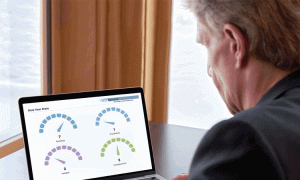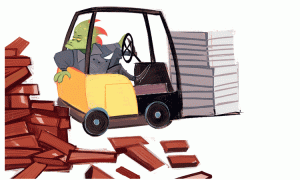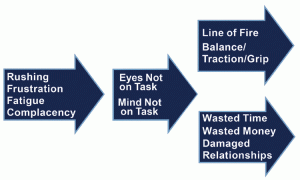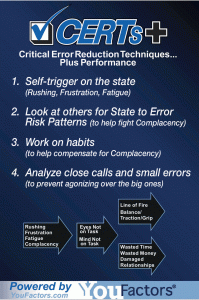The idea or concept that human error is not a cause but it’s a consequence is, in many people’s estimation, a true statement. But to then go one step further and say that the cause is always the system is very misleading. This is not to underestimate the importance of a “well-designed” system, nor is it to diminish the importance of continually trying to improve the system to reduce human error or to decrease any efforts to compensate for human error, such as a seat belt, a fall arrest harness, etc. But rather, to emphasize that to default solely to the system is only partially true or will only get you so far. Autocorrect is designed to reduce typos. But already, it has caused some mistakes with this article. I did not key in “elk-designed” system, but somehow auto-correct thought that was what I meant to say. However, like it or not, I have made more keystroke errors/mistakes than auto-correct has, just getting to this point in the article.
So, the reality, whether or not it’s a pleasing reality, is that “Human Factors” cause the majority of the errors and mistakes we make, which according to researches, is about 80 per day. The easiest way to illustrate this is to simply ask you, when you are working within the same system, whether it’s at the keyboard or with your thumbs on a phone, do you make more mistakes when you’re in a rush? How about when you’re tired or frustrated, and what about complacency? How many times, when you’re in a rush, have you made a mistake, just entering your password? It’s not like you don’t know it. After all, you probably set your own password, so it’s not a training problem. But everybody or almost everybody has made a mistake doing this very simple task. And not just once either. So, the consequence was caused. But it wasn’t caused by the system. And most of the time we don’t make a mistake entering it. But if you’re in a rush or you’re tired or frustrated or so complacent that you’re not really paying attention, then it’s easy-far too easy-to make that mistake. Or, for that matter, any mistake.
“To err is human”. “Haste makes waste”. These are not new expressions. They are “as old as the hills”. What is new or becoming more popular in the safety world, is the idea that “human error is a consequence not a cause”, and that it is unacceptable to use human error as a “root cause”. Which, just for the record, is, in my opinion (and many other’s) a good idea. Because, then, if you stop there, what do you do? Try to hire humans who don’t make mistakes? Unfortunately, if a prospective candidate for a job declared that he or she didn’t make any mistakes, and you hired this person, you have hired a liar (not likely a good choice). So, if you can’t improve the system, which is the case with stairways and doors, etc. (can’t fall, can’t pinch your fingers), what can you do? Well, you can give up. You can also cling to your “mantra” about how it’s all about the system, you can blame the people for making the mistake or making too many mistakes (probably the worst), or you can do something else to reduce the likelihood of human error.

To this end, the safety world is usually at least one step ahead of the rest. Case in point: I was at a company when someone in the shipping department made a serious performance error: he shipped a truckload (54 skids of product) to their best customer instead of to their second-best customer who actually ordered it. Now, in fairness, a lot of products over the years has been shipped to both. So, it’s easy enough to see how someone could make such a simple mistake. But the “investigation” if you could call it that, was to simply look at it as if he was a criminal, and ask, “how many priors” has this man had. Luckily, in his case, there weren’t very many, so that’s where the investigation stopped. “He’s never done something this bad before, and he’s a good employee…”, so he was not disciplined, terminated or anything of the sort.
Whereas, if he had backed the truck off the loading dock (a potential SIF), this company would have done a thorough investigation, and tried to find a way to eliminate or significantly reduce the likelihood of this ever happening again. Perhaps an engineering solution. Maybe a new procedure. But thankfully it wouldn’t have ended with “human error” and questioning his track record. So, as mentioned, in some cases, the safety world is a step ahead of other departments or other areas of the business. At least we know enough not to stop at “Human Error”.
At another facility, after coming to a training session in the day, which the employee requested to be included in, he still had to work the afternoon shift from 3-11. During his shift he backed the fork truck into the shipping door and smashed the brick wall beside it. They simply made it a double door. The fork truck already had many black marks on the counterweight at the back so there wasn’t any motivation to repaint it, and… that was that. Interestingly enough, at least for me, they had a rule about forklift drivers not being allowed to work a double shift, but since he was only attending a training session during the day (which he had volunteered for), this wasn’t considered to be a problem or a contravention to the double-shift rule.
But they did amend the policy to include training sessions or similar events taking place in the day, at least for employees on the premises, to minimize the risk of fatigue for safety-critical jobs. When I said, “but what if he was taking a training session on something else that wasn’t work related during the day, or what if he was driving all day on the way back from a vacation”? In either case, he would still be tired. “Well, we can’t control that”, was the response.

Hopefully, this example illustrates that there are limits to what “the system” can do. But there are many more. Yes, you can make sure that pilots don’t fly more than 12 hours. But you can’t control what they do before they start flying. They can. But the system can’t make them. They could actually compete in a triathlon or a marathon before flying if they wanted to. Hopefully, they wouldn’t. Hopefully they would be more responsible. And hopefully so would a surgeon or a nurse or a crane operator or a forklift driver or anyone in a safety-critical position. But as a wise man once said, “Hope is not a strategy”. It might be better than despair, but it’s not reliable. And telling your spouse that you can’t go to a wedding or to a family reunion or that you have to come back a day earlier from vacation, is pushing the likelihood that “hope” will be enough.
Somewhere along the line, we need to help the people cope with Human Factors. We need to educate or inform them, and more importantly, we need to train them (there is a big difference). Otherwise, some of them will fall prey to the amygdala hijack, when they are rushing and frustrated. They will be overcome with adrenaline and cortisol and be reduced to functioning with their sub-cortex (sometimes referred to as the lizard or reptile brain). Which, speaking for myself, is not who I want operating on me. Nor do I want a lizard flying the plane I’m on. And I doubt if you want a lizard or a reptile driving a fork truck or operating a crane.
When people are tired or really tired, their brains will be filled with adenosine and other chemicals that impair their judgement, mood or their “executive functions” and this will cause them to be more likely to make errors and mistakes. Some of these errors could be critical errors like moving into the line of fire or losing their balance, traction or grip.

These are not things your “system” can change. It’s biology and neuroscience. A much better strategy would be to train them to be able to self-trigger on the rushing, frustration and fatigue: the states you can feel in the moment. This will require enough repetition, 66 according to researches, to be able to rewire their neural pathways so that when they are in these states, they will think risk or danger and keep their eyes and their minds on task. This will help them to avoid being in or moving into the line of fire, and to look for and think about things that could cause them to lose their balance, traction or grip. And when complacency is the dominant state, people need to understand that it will naturally lead to mind not on task (it’s not a character flaw). So, to help compensate for that, it’s important to get your employees work on their habits, so that what they do automatically will be the right thing, or in the case of injuries, be safer like leaving a safe following distance when driving (so you have more time to react) or looking over your shoulder before backing up or reversing. And finally, if you can get your employees to look for state to error patterns in others, then it will help to bring their minds back on task. Because when you see risk, you will also think about your risk in the moment (when you see someone following too closely you will also check your own following distance). In other words, this technique fights complacency.

So yes, human error is a consequence. But in most cases, it is a consequence of human factors or a combination of human factors, like rushing and frustration or fatigue and complacency. And to think that you can fix it all with a better system is noble, it’s better than blame. But it’s just not reality…
ABOUT THE AUTHOR
Larry Wilson is a pioneer in the area of Human Factors in safety. He has been a safety consultant for over 25 years and has worked on-site with hundreds of companies worldwide. He is the author of SafeStart, an advanced safety and performance awareness program, successfully implemented in more than 3,500 companies, in over 60 countries, with more than 4 million people trained. He co-authored the book “Inside Out: Rethinking Traditional Safety Management Paradigms” and authored the book “Defenseless Moments: a Different Perspective on Serious Injuries”. Larry is the moderator of the SafeConnection expert panels and an active keynote speaker at health and safety conferences around the globe.

For more information
Location: https://g.page/SafeStart-International?share
Tel : +91 44 42321920
Mail: [email protected] /
Web: http://asia.safestart.com

